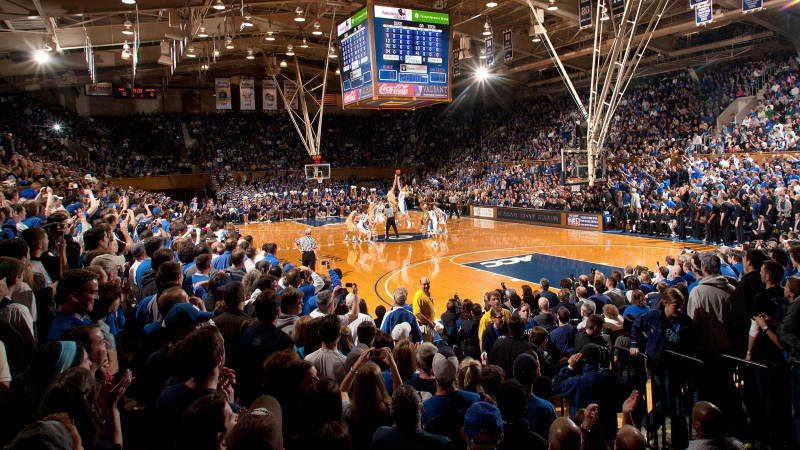Tech Focus: Acoustics, Part 1 — In-Venue Noise Remains an Issue
The challenge is still to balance volume and intelligibility
Story Highlights
Architects of sports venues have become de facto sound specialists, pushed into that sonic arena by teams and leagues that have come to understand just how much home-team fans’ cheering can translate into a home-field advantage. This is especially the case in NFL venues, where home-team vocalizations are meant to disrupt quarterback cadences.
Architecturally, this can translate into anything from highly reflective materials used in shell and roof/ceiling construction to details, such as positioning seating closer to the field or court or installing aluminum benches for fans to stomp on.
There have been a few occasions when venues have tried to use technological means to amp up the sound. These have tended to end badly. For instance, in 2015, the NFL’s Atlanta Falcons were fined $350,000 and loss of a draft pick when an investigation prompted the team’s owner to acknowledge that that fake crowd noise was played inside its former Georgia Dome home stadium. That same year, the Cleveland Browns were fined $250,000, and GM Ray Farmer was suspended four games for his violation of the league’s policy on electronic noise enhancement.

Acoustics were improved by consideration of sound during design of Duke University’s Cameron Indoor Stadium.
The issue still crops up; one A/V integrator reports that he has heard of at least one PA-system manufacturer that had approached a vendor about the sale of DSP that can digitally enhance crowd noise. (That may not necessarily be as nefarious as it sounds: the number of new loudspeaker-systems manufacturers and distributors in the U.S. market more than doubled in the last decade, and the number of regional and local sports venues that want to emulate major-league fan experiences — and where NFL and NBA noise ordinances are unenforceable even if they’re even known about — is nearly uncountable.)
Physics 101
Mostly, say A/V integrators and consultants specializing in sports-venue sound, the main challenge remains physics 101: trying to balance the demand for high SPL volumes with both speech intelligibility and full bandwidth for music reproduction.
“Basic acoustic principles still apply,” says Vance Breshears, a director at acoustical-consulting firm Idibri, whose portfolio includes AT&T Park, Chase Field, Fifth Third Bank Stadium, and the Circuit of the Americas F1 track. “It’s about shifting the balance between acoustical energy for the home-court advantage and intelligibility for the PA. And it’s a tough balancing act.”
He notes that sports venues are increasingly borrowing techniques from entertainment venues, which is not surprising given the degree to which music and other theatrical elements have become intertwined with sports events in recent years. These include a technique used often in performing-arts centers: more-reflective materials are located closer to seating areas, where the early reflections help add a sense of immediacy to the aural ambience around fans, and more-absorptive materials are in more-distant areas, such as rafters and fixed domes, where they can mitigate longer reverb times that can turn music and speech into mud.
Breshears points to new acoustical-treatment products that make it easier to tune venue acoustics spectrally, by truncating specific frequencies. That’s easier in the upper and upper-mid frequency ranges but becomes more challenging below 500 Hz, the direction music has been trending for some time.
“The thinking used to be that thicker treatment was what you needed to manage lower frequencies, but what we’ve come to realize is that you also need air behind that treatment to make it most effective,” he explains. This pursuit is also being helped by the greater use of predictive-analysis software, such as EASE, which can model the spatial and acoustical characteristics of various room designs — specifically, the noise-reduction coefficient (NRC), a representation of the amount of sound energy absorbed upon striking a particular surface — in a virtualized environment.
Can Systems Solve Acoustics?
As good as acoustical modeling and treatment have become, not every sports venue gets the benefit. “In the biggest of them, acoustical treatment often ends to get value-engineered out,” says Justo Gutierrez, director, A/V for sports and live events, Diversified, an A/V integrator whose projects include Safeco Field and O.co Coliseum. Diplomatically opining that acoustical issues are often barely acknowledged in sports-venue construction, he adds that it’s more of a problem than it might seem, because it puts the onus for solving acoustical issues on sound-system design.
“Scoreboards and other very visible elements of the design tend to drive the costs, but ‘invisible’ aspects like acoustics tend to get ignored or minimized,” he explains. “The problem is, a sound system is only as good as the environment that you put it in.”
In fact, acoustical treatments can cost more when they have to be applied retroactively instead of being implemented as part of a construction or renovation project. That’s because they have to address architectural aspects put in place without consideration of their impact on sound propagation and because they often come after a new sound has been tuned to adapt to an acoustically challenging space and will have to be retuned after treatment is installed.
Gutierrez, who previously worked at consultancy WJHW and A/V integrator AVI/SPL’s sports division, says consultants are in the best position to advocate for acoustical treatments during the design phase and before construction begins. He cites WJHW’s work on Duke University’s Cameron Indoor Stadium — home to the “Cameron Crazies”, whose loud cheering has registered as high as 121.3 dB — as an example of an acoustical outcome that was improved by early collaboration with the architects on the project.
“One way or another,” he says, “there’s going to be a cost associated with not paying attention to acoustics.”
Click here for Tech Focus: Acoustics, Part 2 — Is ETFE a Miracle Material or Sonic Speed Bump?.
